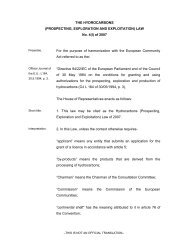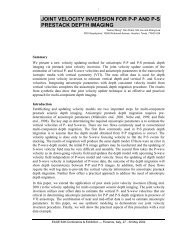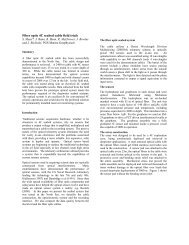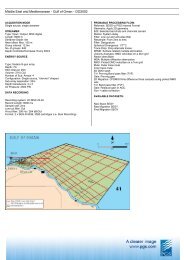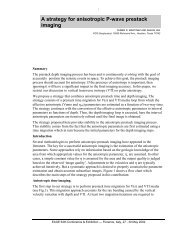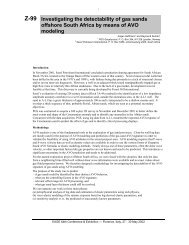OTC 16945 True 3D Data-driven Multiple Removal ... - PGS
OTC 16945 True 3D Data-driven Multiple Removal ... - PGS
OTC 16945 True 3D Data-driven Multiple Removal ... - PGS
Create successful ePaper yourself
Turn your PDF publications into a flip-book with our unique Google optimized e-Paper software.
4 <strong>OTC</strong><br />
defined grid. A data-<strong>driven</strong> regularization method, such as<br />
described in Schonewille et al. (2003) that uses the exact<br />
source- and receiver coordinates and allows for regularization<br />
to any user-defined grid is preferred. The proposed preprocessing<br />
sequence is very similar to the well-established<br />
pre-processing for the application of 2D SRME to marine data.<br />
The sequence includes: the removal of the direct wave and its<br />
surface reflection, the removal of non-physical noise and the<br />
directivity effects from source- and receiver arrays (optional),<br />
the recovery of missing shots and intermediate missing traces,<br />
shot interpolation (optional), and the extrapolation to zero<br />
offset of the inline component of the offsets. It is remarked<br />
that, after the optimal sequence and parameterizations have<br />
been found, all steps can be integrated into standardized flows<br />
to increase computational efficiency, and to minimize user<br />
interaction.<br />
Step 2: <strong>Multiple</strong> prediction through reconstruction in the<br />
crossline direction<br />
After pre-processing, the stacking of the multiple-contribution<br />
traces is carried out in two steps, first in the inline direction<br />
and secondly in the cross-line direction. Stacking of the<br />
multiple contribution traces in the inline direction is<br />
straightforward, as the sampling after pre-processing is<br />
sufficient. However, a direct Fresnel summation in the<br />
crossline direction leads to artifacts due to aliasing and<br />
insufficient aperture. Instead, the crossline summation is<br />
carried out implicitly through a reconstruction of the Fresnel<br />
zone, from a sparse-inversion based estimation of hyperbolic<br />
or parabolic events, with discrete curvatures and apex<br />
positions.<br />
In the literature, three methods for sparse-inversion based<br />
Fresnel zone reconstruction have been described: 1) using a<br />
time domain hyperbolic Radon transform (van Dedem and<br />
Verschuur, 2001); 2) using a frequency domain parabolic<br />
Radon transform (Hokstad and Sollie 2003); and 3)<br />
interpolation using Stolt migration operators (Trad, 2003). The<br />
time-domain approach has been shown to provide good results<br />
for <strong>3D</strong> SRME, but is rather expensive. The frequency domain<br />
approach is computationally much more efficient, and has<br />
been shown to provide a good uplift compared with 2D SRME<br />
(Hokstad, 2003). However, using the frequency domain<br />
approach, only sparseness in the spatial direction can be<br />
enforced (Cary 1998, Trad 2003). As a result, for more<br />
complex data with events at many different apex positions,<br />
results may not be as good as with the time-domain approach.<br />
Interpolation with Stolt operators can provide sparseness in<br />
both time and space. The basic algorithm is computationally<br />
very efficient, but shows artifacts. These artifacts can be<br />
reduced, but this does increase the computational costs<br />
somewhat. This is a relatively new technique, and the<br />
suitability for <strong>3D</strong> SRME is under further investigation.<br />
As the reconstruction has to be carried out for all source and<br />
receiver combinations, computational efficiency is vital for the<br />
economical viability of sparse-inversion based <strong>3D</strong> SRME. In<br />
this paper, an approach is used that is based on the standard<br />
time domain approach described by van Dedem and Verschuur<br />
(2001) but which is much more computationally efficient. The<br />
computational speedup has been achieved through more<br />
efficient sparse matrix computations in a modified conjugate<br />
gradient scheme, and a data <strong>driven</strong> reduction of the model<br />
space. The results are comparable to those from using the<br />
standard time domain approach, and show significant<br />
improvements over any 2D implementation.<br />
After stacking the multiple-contribution traces in the Fresnel<br />
zone, a single trace with the corresponding predicted multiples<br />
is obtained, which can be used in the last step: the adaptive<br />
subtraction of the predicted multiples from the input data.<br />
Step 3: Adaptive subtraction of predicted multiples<br />
In the last step, the predicted free-surface multiples are<br />
subtracted from the input data using the minimum energy<br />
criterion, which states that the total energy after subtraction of<br />
the multiples should be minimized. In adaptive subtraction<br />
techniques, the predicted multiples are removed using Wiener<br />
filters designed in overlapping windows. In general, great care<br />
must be taken in choosing the filter length and the window<br />
size. If the filter length is too long, it is possible to remove<br />
primaries. Also, choosing too small a design window may lead<br />
to primary energy being affected when multiples and primaries<br />
are interfering. In <strong>3D</strong> geometries, the application of 2D<br />
multiple prediction methods leads to multiples that are<br />
predicted too late in time. Using a <strong>3D</strong> prediction scheme, the<br />
timing of the predicted multiples is better aligned with the<br />
multiples in the input data, leading to better removal of<br />
multiples. The more accurate timing of the predicted multiples<br />
allows the use of more conservative parameters in the adaptive<br />
subtraction, giving better preservation of primary energy.<br />
Field data example from the Norwegian Sea<br />
In this section, results from a <strong>3D</strong> data set from the Norwegian<br />
Sea are shown. <strong>Data</strong> were shot in a dual-source 10-streamer<br />
configuration, with a 100 meter streamer separation and 500<br />
meter sailline separation. Results for a single offset line for<br />
one of the streamers have already been presented in Van<br />
Dedem and Verschuur (2001). Here, a total of 159 offset<br />
planes with a spacing of 12.5 meters were processed to allow<br />
further prestack processing after the application of <strong>3D</strong> SRME.<br />
Figure 9 shows the results for a typical shot gather. Figure 9a<br />
shows the input gather after pre-processing. Figure 9b-c show<br />
the predicted multiples after 2D and <strong>3D</strong> SRME respectively. A<br />
comparison indicates that, where the 2D multiples have all<br />
been predicted too late in time, the timing of the <strong>3D</strong> predicted<br />
multiples is almost perfect. Figures 9d-e show the results after<br />
adaptive subtraction using the 2D and <strong>3D</strong> predicted multiples<br />
respectively. It is remarked that a very mild adaptive<br />
subtraction approach was used in order to preserve the primary<br />
energy as much as possible. Note the much-improved removal<br />
of multiple-energy using the <strong>3D</strong> predicted multiples. As a<br />
result, the remaining primaries have become much more<br />
visible. Figure 10 shows the same comparison for an inline at<br />
stack level. Note again the difference in timing between the<br />
2D and <strong>3D</strong> predicted multiples, shown in Figs. 10b and c. As a<br />
result, after adaptive subtraction, the <strong>3D</strong> result compares<br />
favorably to the 2D results. Both the first-order water bottom<br />
multiple (between 1.0 and 1.2 second), and the reverberations



